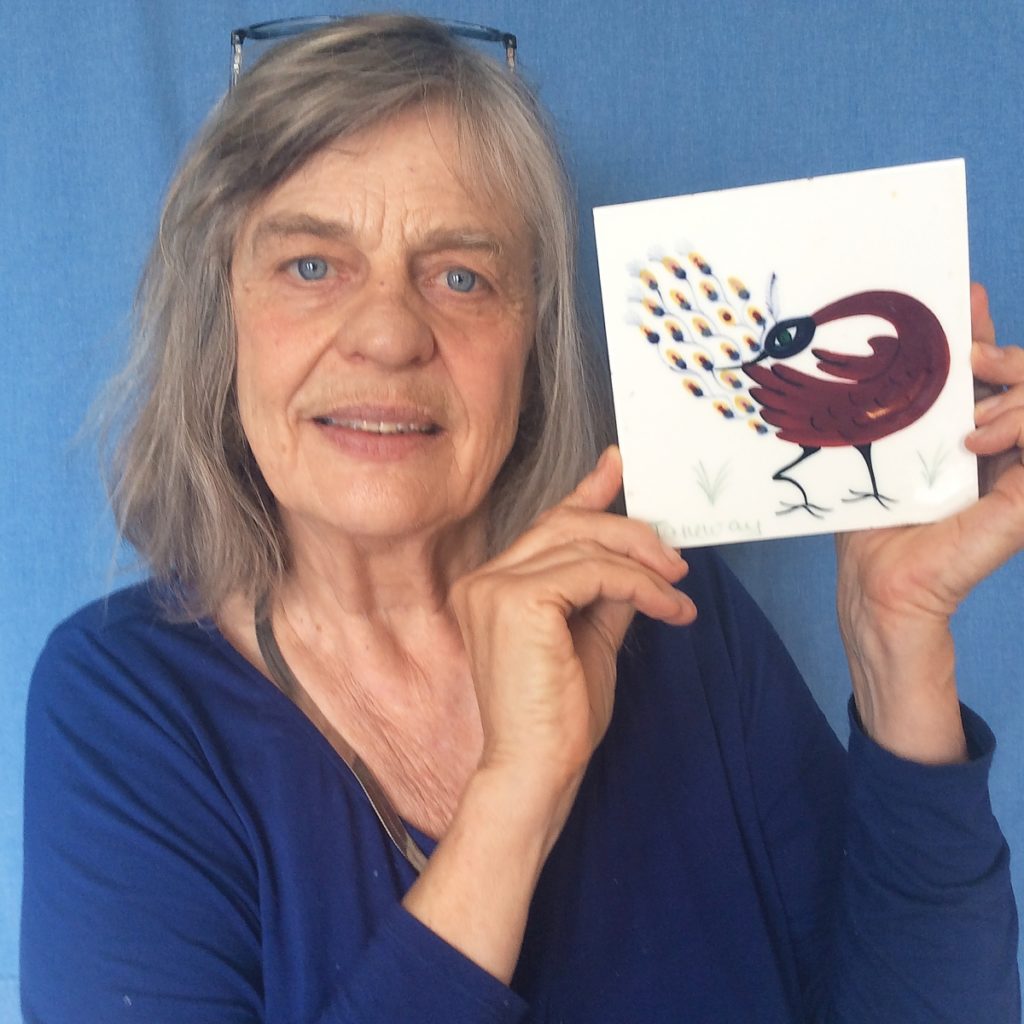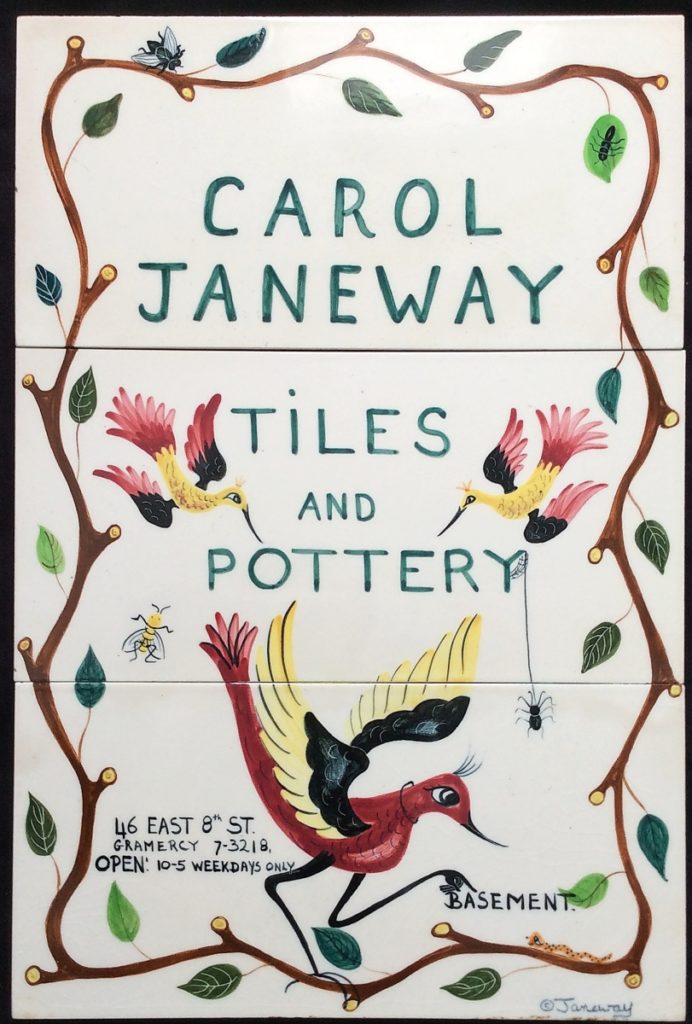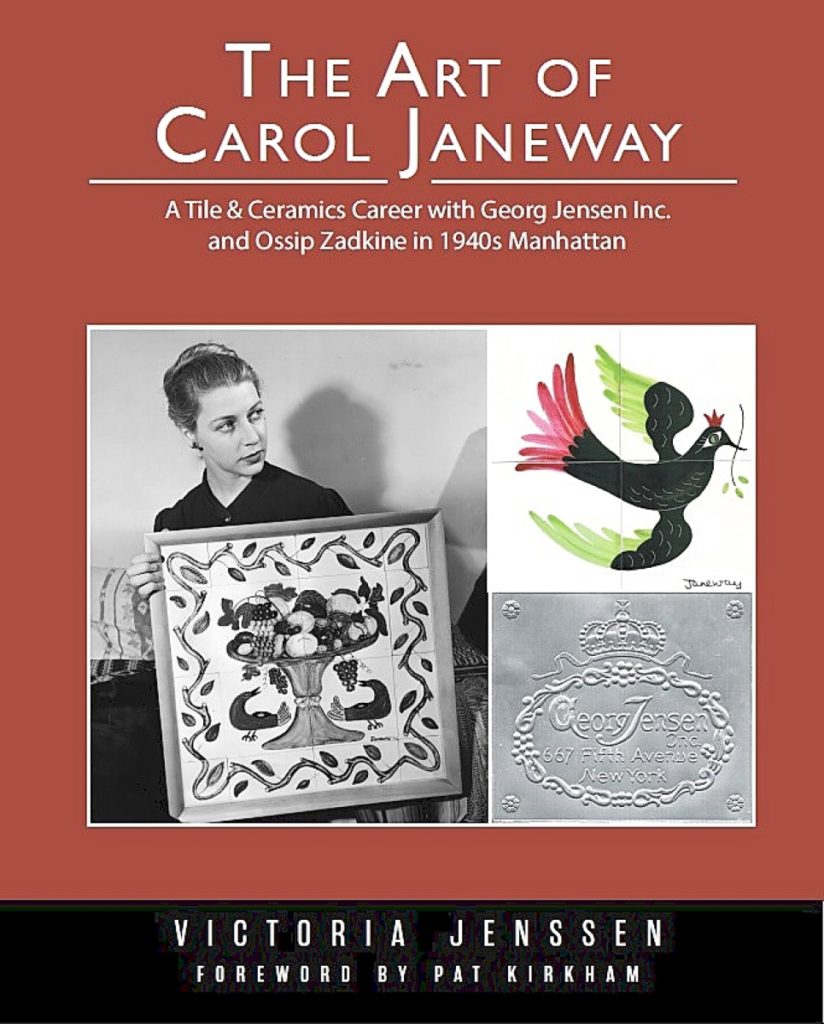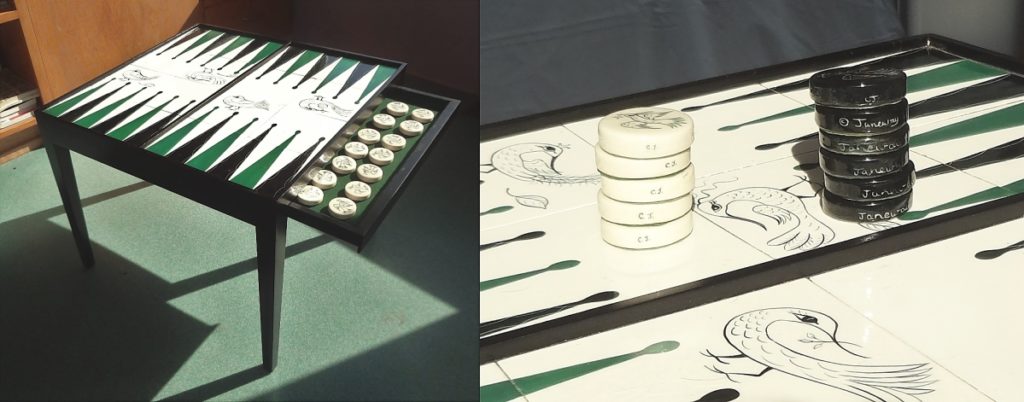
Vicki Jenssen with a pre-1947 Janeway Wheeling porcelain tile
from her family collection.
Vicki Jenssen is an art historian, retired archaeological conservator and educator, and author of The Art of Carol Janeway, a comprehensive compendium that catalogs the life and work of Carol Janeway (American, 1913-1989). Referring to Janeway merely as a “ceramicist” only touches upon the breadth of her talents which, in addition to painting, were manifold and developed throughout her career. Despite their widespread production, Janeway’s ceramics are seldom found on the market today and most are off view in American museums or private collections. To learn more about this almost fantastical, almost forgotten figure, we corresponded with Jenssen via email.
How were you first introduced to Carol Janeway’s ceramics?
From childhood, our kitchen peninsula was set with a glossy four-tile ochre Janeway squirrel winking at me with its human eye. The tiles were signed “Janeway,” and despite my parents’ admiration of these tiles, I was sure at 5 years old that I could do better. Now I marvel at the deft freehand fired paintings Janeway made of birds, animals, reptiles and yes, squirrels. I came to understand that Janeway tiles were part of the reason my father and uncle moved the family up from Brooklyn to the backwoods Berkshires after the war to source hardwoods. They called themselves Jenssen Brothers and they were fabricating those wooden trays set with Janeway tiles for Georg Jensen Inc, Fifth Avenue, New York.
In cleaning up my parents’ effects in 2001 in South Egremont, Mass., I came across a box with many Janeway four-tile sets, one nicer than the next. Nearby there was her 1950 book, Ceramics & Potterymaking for Everyone, a how-to book with hints about her intriguing life. Although I was a trained art historian and art conservator, I had never thought to ask my parents about Janeway or the Georg Jensen connection. Fortunately, the internet answered just enough questions prompting me to drop everything and, with my family’s forbearance, to spend the next 15 years seeking out her archive, collecting tiles and researching. Most wonderful was meeting owners, usually daughters of the original owners. Janeway tile trays and decorated dinnerware were popular wedding presents in the 1940s. When I met up with Janeway’s daughter Kiske, a Franciscan nun from her middle life onward, the Abbess of the Monastery of Saint Clare offered me the Bishop’s Room for lodgings! I met other equally amazing owners and characters in Janeway’s life story. I visited her grandparents’ Queen Anne house in Brooklyn, used as the set for Sophie’s Choice (1982). And yes, that house had a unique tiled fireplace which must have impressed Janeway as a small child.

Janeway’s colorful ceramic tile street-level sign
indicating the location of her basement studio, 1947-49.
Tell our readers a bit about the book.
I had originally thought to write her biography, that is how interesting her life story is. But the research turned up piles of information about her decorated ceramics themselves and the marketing of her output and in researching I learned how unrecognized these ceramics are. The art historian in me kicked in, I decided the world needed what I needed: a monograph and catalogue for curators, collectors, researchers and people nostalgic for a bygone New York City. Here it is, 15 years later… It is organized like a museum exhibition [or] symposium catalog. First there is the biographical essay, followed by some 17 unlinked essays usually written by invited scholars, in this case I wrote all the essays. The last half of the book is an illustrated catalogue raisonné for all us collectors and curators who want to place our Janeway finds in her output. Updates will appear on the website: www.caroljaneway.com.
Janeway’s work was prolific and received ample press coverage during her career, why do you think it has disappeared from the market?
From 1942 through 1945 alone, she and her work had been profiled in syndicated newspaper articles and women’s magazines. In 1946, Life magazine claimed to potential advertisers that their 1945 photographic essay on Janeway’s tiles had brought $50,000 worth of orders to Janeway. Multiply that dollar by 10 or 12 to get today’s equivalent! Her work was sought nationwide, particularly the tile fireplace surrounds. From 1942 through 1948, Georg Jensen Inc on Fifth Avenue in Manhattan offered her wares in their illustrated yearly mail-order catalogs. In 1950, she announced her retirement in the Lyons Den nationally syndicated column, the reason given was lead poisoning and the publicity machine stopped.
The families that owned Janeway tiles knew their authorship: each one was signed on its front. Often the children, boomers like me, formed their own connections with her art and, when they inherited them, chose not to sell them. The son of Janeway’s lawyer, Phil Wittenburg, skinned the Janeway tile fireplace tile facing off when he sold the family brownstone in Manhattan. He is in his 90s and repurposed them for decorations in his bathroom! Not selling.
Until recently Janeway did not have a Wikipedia page, there were no Google Images, there was no website to explain to people just what a ceramic signed “Janeway” could be. Her obit in the New York Times would convince you that her work was in all the major New York City museums (not so, long story) and that Wedgwood had put her designs into production in 1948 (also not so, also a long story). In the days before Janeway’s ceramics had an internet presence, people finding the random tile or plate put them on eBay or Etsy and I would buy them. They are not handmade tiles, she hand-decorated industrial blanks. But now that Google searches pull up lots of images and articles about Janeway ceramics, very few show up for sale. Seems everyone is hanging on to them awaiting, what, a publicity boom? A market? Marilyn Monroe’s estate included five Janeway doorknobs. One lot of four sold for $3,525 with Christie’s Los Angeles in 2001. The other doorknob sold for $950 with Julien’s Auctions in 2005. Two decorated Janeway tiles were offered on eBay last spring for $150 apiece and got that price. Nothing since.

Courtesy of FriesenPress.
Would a line of authorized Janeway reproductions ever be possible?
Surely anything is possible if one secures the rights. Janeway’s daughter had no interest in seeing Janeway potholders or tea towels. The Maryhill Museum of Art in Goldendale, Wash., has a complete blue vs white chess set, one of 400 sets in its international chess collection. I have a complete backgammon gaming table including the markers and drawers for their storage. People really like these Janeway board game pieces and their feel. For now, replication is an unresolved topic.
What is your fondest wish now that your book has brought Janeway and her art back into the public eye?
The good-girl answer is that I want the book to reach my fellow collectors and curators so that we all can understand what we have and what we should want in our collections and those of museums. The Museum of Modern Art has a popular portrait of Janeway by surrealist photographer Maya Deren (Ukrainian, 1917-1961), yet they do not provide any artistic context when they display that photo. Incidentally, Janeway owned that unique print and seems to have collaborated with Deren on the poses of this and other Deren portraits.
Yet, the fun-loving girl answer is that I wish someone will make a screenplay about her very cinematic life or some portion of it. Janeway worked in Moscow in 1933 and 1935, rode down to the Black Sea on a Soviet train, guarded by soldiers, she sat on sacks of gold pretending not to understand Russian nor what was in the sacks. She had been a beautiful fashion model abroad, yet she also lived among bohemians in England and then in Manhattan. How quickly she developed those tile designs and rose to the top of Fifth Avenue at age 29! Well, she was the protegee of a famous Russian-Parisian artist, Ossip Zadkine (1888-1967), during his World War II exile in New York City. She helped preserve Greenwich Village, working with Jane Jacobs and others against Robert Moses of current Straight Line Crazy (2022) fame. Janeway knew famous people and dined out on great stories: wish we had more of them. She was a beguiling woman capable of winning people over yet, when she felt slighted, look out! The lead poisoning part of her story begs comparisons with stories like La Boheme. Her late-life hoarding is what preserved her papers and story for us.
I wish I had the novelist’s ability to put her life into a more entertaining format! I left so many stories out of The Art of Carol Janeway, a reference book.

Janeway-decorated backgammon board and marker from Jenssen’s collection.
After 15 years of researching, compiling and writing this comprehensive catalog, what is your next project?
I have collected hundreds of silkscreened midcentury tiles in order to nail the story about Designed Tiles studio, founded in the Flatiron district by artist Harold Ambellan before 1942 and lasting well past the sale of his business in 1958 to friends. Janeway learned about underglaze tile decoration there among the Ambellans, her friends, and the wartime ex-pat artist community. Collectors and curators might want to know more about them, they have charming designs, no kitsch. I put an article in Tile Heritage [“Designed Tiles: A Silkscreen Studio in New York, NY 1939-1978”] this summer and hope to get this information to more collectors. Next would be a website, I suppose.
[Editor’s note: The Art of Carol Janeway: A Tile & Ceramics Career with George Jensen Inc. and Ossip Zadkine in 1940s Manhattan is available in hardcover, paperback and digital editions from FriesenPress.]-Z.G. Burnett




